Feeding Your Puppy
How to feed your puppy
Before we discuss WHAT to feed let’s talk about HOW to feed your puppy.
Corgis are VERY smart and if allowed to do so they will train you on how and when they want to eat. This will set up bad habits that you will have to try to correct later. Taking the time now to work on good eating habits and being a strong disciplinarian at this point will save lots of frustration later.
Your puppy/dog should eat regular meals throughout the day and not be free fed.
What is free feeding? Free feeding is when you fill a bowl with food and the dog is allowed to eat anytime throughout the day. Research shows that free feeding leads to orthopedic problems, obesity and shortened lives. You should give your puppy or dog 10 to 15 minutes to eat then remove any food that they have not eaten until the next meal.
You should also teach your puppy to wait politely for you to prepare its meals, set the bowl down and be released to its meal without jumping, barking or other impatient behaviors. Your puppy has been taught to sit or mand before it is fed. You will need to continue working with your puppy daily to make sure that they continue their good manners.
Your dog should be taught to eat in different locations. This will be important if you board your dog, leave them with friends or family, or if they have to stay at the vets. This can easily be accomplished by feeding your puppy in different rooms in your house, the crate, the car, outside, etc.
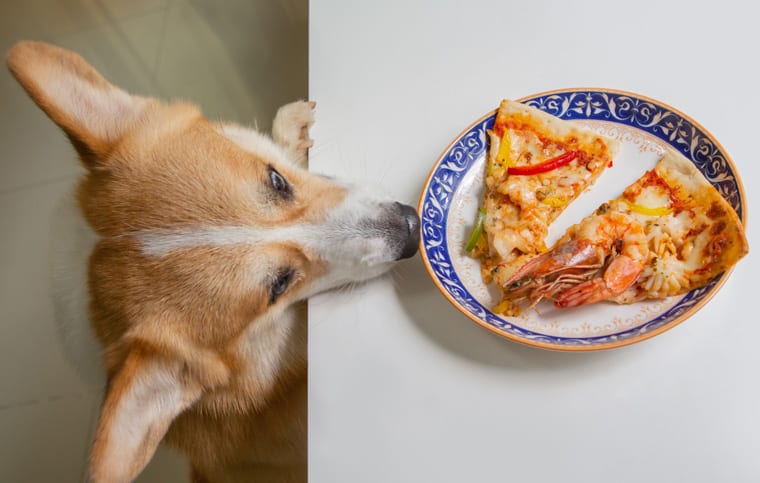
What and how to feed your puppy
During the time that your puppy is going to the vet to complete their shots, the veterinarian will be able to help you determine if your puppy is of an optimum body score. Once your puppy gets older you will need to evaluate its body score to make sure that your puppy is fit and not getting too fat.
By keeping your puppy or dog fit, you will reduce back issues that Corgis are prone to (since they are long bodied dogs) and research has shown that fit dogs that are not overweight live up to 2 years longer that overweight dogs. Research also shows that a feeding a high quality food helps reduce hip dysplasia.
Your puppy is eating Purina Pro Plan Chicken & Rice Under 1 year puppy food. I would suggest keeping the puppy on the same food until they are well adjusted to their new home. If you decide to change food brands do so by gradually mixing the new food in with the old food. I normally leave my puppies on puppy food until they are around 6 months old then I mix puppy food with Purina Pro Plan All Life Stages food. This slows down the rapid growth and gives their joints time to mature as their weight increases.
The only dog food brands that are research based are Purina, Hill’s Science Diet and Royal Canin. These are high quality foods that exceed the AAFCO minimum nutritional standards and are backed by feeding trials, quality control and guaranteed nutritional analysis. I personally do not recommend grain free diets or raw diets. I have personally known dogs that have developed pancreatitis and died when eating Blue Buffalo so I suggest that you do not feed it. I would also like to caution you against switching to brands sold by breeders, trainers, etc. They often promote untested brands in their business for a commission from the dog food company.
Dogs do have personal taste preferences and sensitivities to food like people. Some dogs do not like beef while others may not like Salmon or Lamb. Some dogs may develop diarrhea or vomit if they eat corn while others may itch after eating Chicken. If your dog becomes sensitive to a particular ingredient you may need to perform an elimination diet to determine what ingredient is causing the problem.
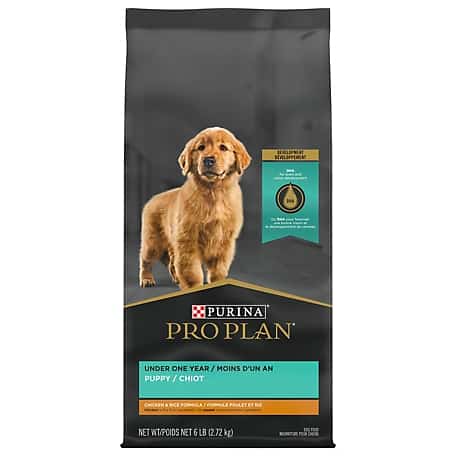
Eating Issues
Corgis are very food oriented but sometimes the move to a new home can cause a digestive upset and your puppy may not want to eat or have diarrhea. Here are the main problems that I see when puppies go to their new homes.
1. The puppy gobbles its food down without chewing which is not ideal. A couple of things to try are:
a. Put down a portion of the food and add additional portions after they have eaten the first portion.
b. Another option is to get a Slow Feed bowl (see our Recommended Corgi Products page) or use a muffin tin to split up the food.
2. The puppy does not eat very well due to being at a new home. If that happens:
a. Reduce the amount that you are feeding
b. Feed your puppy in a crate to reduce distractions
c. Give your puppy 15 minutes to eat. If they do not finish their food, remove the food and try again at the next scheduled time.
The goal is to teach the puppy to eat when fed without inhaling it. A few things to remember are:
Do not leave the food down.
Do not beg your puppy to eat.
Do not hand feed.
When you do these things, the puppy is training you not you training the puppy.
3. The puppy may experience diarrhea. This might occur if the puppy is nervous being in its’ new home. I have included a few packets of a probiotic called Fortiflora in your blue folder. Add one packet to the food each day. This is a great product to have on hand. It can be fed daily as well.

How much to feed
Your puppy is eating approximately 1/2 to 3/4 cup of food per feeding and is being fed twice a day – in the morning and at night. Set feeding times that match your schedule. Remember to allow enough time to take the puppy out to the bathroom after eating.
The amount of food that puppies need varies on their growth and activity (3.5% – 10% of their body weight). The guide on the bag is just a guide. You will gradually increase the amount of food that the puppy eats as it grows. Since you will be taking your puppy into the vet every 3 weeks for shots it is a good idea to ask the vet if the puppy is of an appropriate weight. By keeping your puppy or dog fit you will reduce back issues that Corgis are prone to since they are long bodied dogs.
You can evaluate your dog’s body condition and increase or decrease food as needed. Use the chart below along with these recommendations to determine your dogs’ body condition.
1. Feel your dog’s ribs. Now feel the back of your hand using the same amount of pressure(between your wrist and knuckles). They should feel similar. You should be able to feel your dog’s ribs.
2. Next look at your dogs’ waist. You should be able to see that your dog has a waist when looking at it from above.
3. Lastly evaluate your dog’s tuck. Your dog’s abdomen should be tucked up when looking at it from the side.
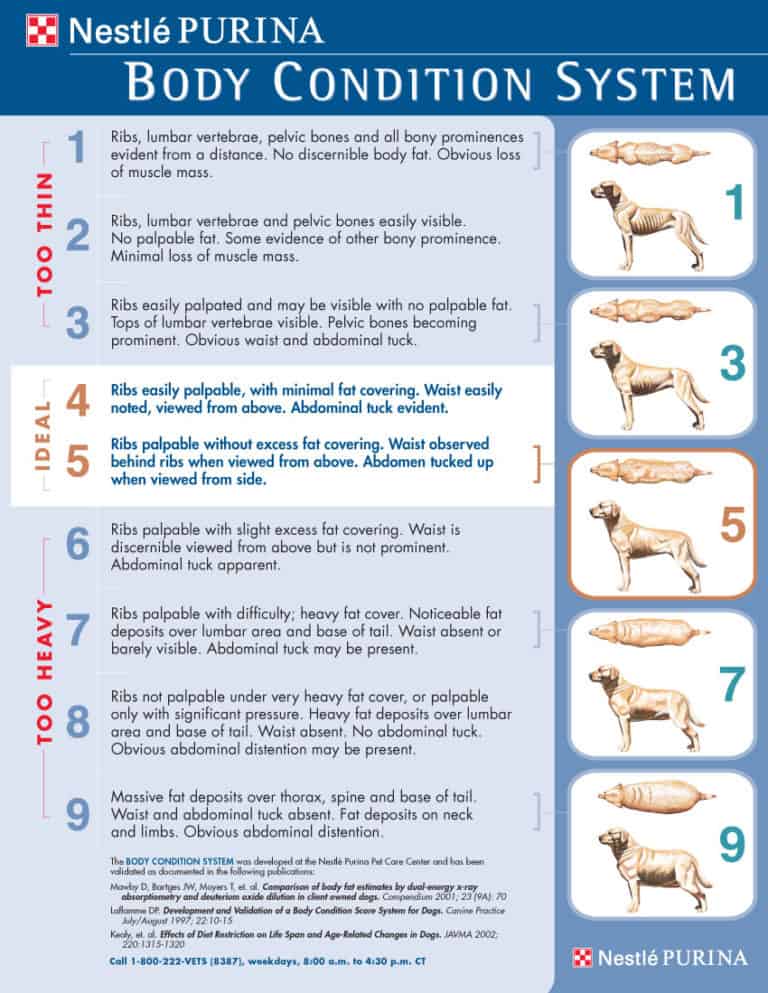
Food Additives
I personally add FortiFlora (probiotic) and fish oil to my adult dogs food. The probiotic helps keep their digestive system in check and the fish oil helps with their hair and skin. I also believe that it helps with shedding. My dogs also get a NuVet plus vitamin daily to ensure that they are getting all of the nutrients that they need.
I add a variety of probiotics to my puppy’s food during the weaning process to help establish beneficial bacteria in the gut. When puppies leave my care they are still getting live culture yogurt, Keifer or FortiFlora on their food once a day. I would encourage you to continue this routine during the stressful time of going to a new home and settling into your family. Our puppies receive 1/2 of a NuVet plus vitamin to help strengthen their immune system and suggest that you continue on with this practice to ensure that they have a strong immune system which will help make the transition to their new home less stressful.
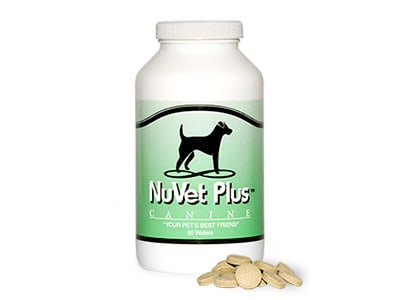
Feeding Schedule
Your puppy has been eating twice a day – in the morning and at night.
Remember that these dogs are VERY SMART! They will train you if you are not careful. Although it is cute when puppies bark to be fed, it is not something that you will want to deal with for years in an adult dog. If your puppy barks to be fed, do not look at it or talk to it. If it barks when you are preparing its food, move further away from its food. Move to another room if you need to do so and come out or move toward the food when the dog has been quiet for at least 5 minutes. If it starts to bark again when you begin to prepare its food, once again move away from the food or move to another room and repeat the process until the puppy is quiet during food preparation.
Many human foods such as carrots and green beans are good for dogs. I use cheddar cheese, hot dogs, and cooked meats to train dogs. Foods that are NOT SAFE for your dog include cooked bones, chocolate, onions, raisins, grapes, and raw white potatoes.

Training Treats
If you continue with positive reinforcement training, you will need lots of treats. You can buy treats but that will get very expensive. My suggestion is to use homemade treats most of the time and use store bought treats or Bark Box treats (if you subscribe to Bark Box) to change things up. My dogs really enjoy the monthly Bark Box and I like the fact that you can customize the box for the needs of your pup and if your dog does not like a toy or treat they will replace it for free. My pups like the toys too – they are durable and have different textures and lots of sound including squeakers and crinkle which they love.
Homemade treats include pieces of cheddar cheese (cut into tiny cubes), string cheese, hot dogs and dry cat food. Your puppy has been trained using cheddar cheese and will do anything for cheese.
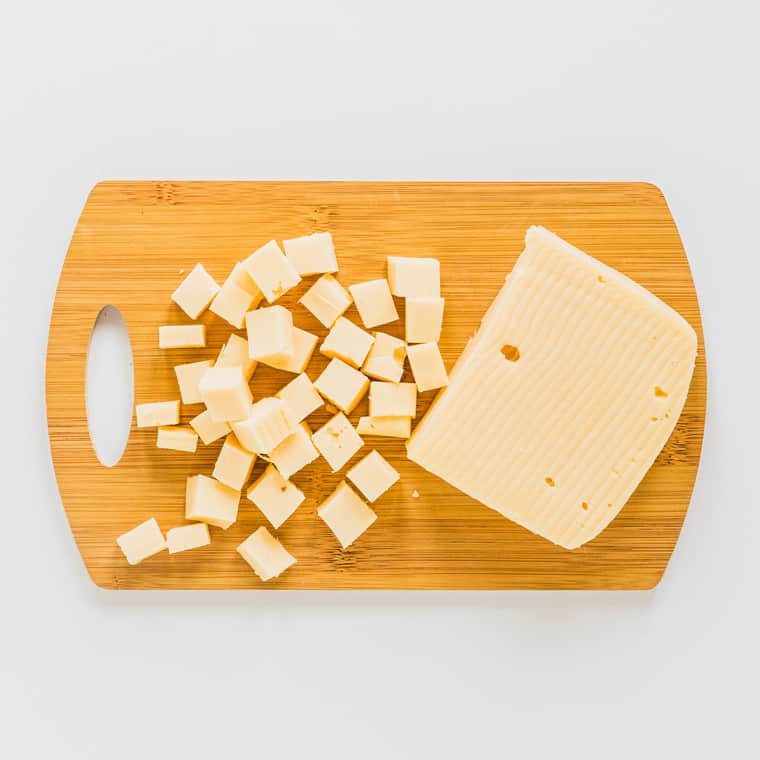
Feeding multiple dogs
Meal time can be a time of high anxiety in a multi dog household. Start teaching appropriate meal manners right from the start. Dogs should not approach another dog’s bowl until that dog is done with its meal and has moved away from its bowl. Teach your puppy to sit while you put the bowl down. Each dog needs its own regular location for its meals separate from other dogs. Corgis are prone to resource guarding because they are so food oriented. Feeding each dog in their own place will help reduce resource guarding.

